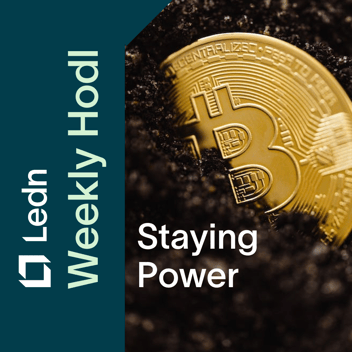Weekly Hodl: The "new" GBTC/BTC Trade
.png?width=1080&height=1080&name=IG%20BEC%20(11).png)
Ledn’s Weekly Hodl: The “new” GBTC/BTC trade
Week of Monday July 17th
Start earning up to 9% APY on your crypto with a Ledn Savings Account.
Bitcoin Market Analysis
Bitcoin closed last week at $30,249 on thinly traded volume. It was bitcoin’s fourth consecutive week closing above the all-important technical support of $30k. At the time of writing, bitcoin is fighting to stay above it - currently trading at ~$29,800.
Looking at near-term catalysts, the next market event will be the Federal Reserve’s interest rate decision scheduled for next week. Despite inflation dropping down to 3% last week, the market is pinning the odds of another 0.25% rate hike at 99.80%. Additionally, earnings season for U.S. equities continues next week, and markets could react as it digests the Q2 results. We are also less than one month away from the first SEC deadline to approve, extend or deny the bitcoin spot ETF application from ARK 21 Shares.
In terms of key technical support and resistance levels, we continue to monitor the $35k resistance to the upside, and the 200-week moving average price as support - currently at $27k.
Our Weekly Blog: The “new” GBTC/BTC Trade
The Blackrock Spot Bitcoin ETF application has caused a great deal of interest in bitcoin recently, helping prices surge by more than +18%. However, the announcement has also triggered a particular trade dynamic that is leading to an increase in spot sales of Bitcoin, which, in turn, has also put downward pressure on price: this trade dynamic is the GBTC discount-to-NAV arbitrage.
In today’s essay, we’ll explore the mechanics of this trade, why it has introduced selling pressure on the spot bitcoin markets, and what the downstream effects will be when the trade is unwound.
Background on the Grayscale Bitcoin Trust
Grayscale is an American company established in 2013 by Barry Silbert. In the same year, it launched the first bitcoin trust. In 2015, the Grayscale Bitcoin Trust began trading over-the-counter on the OTCQX market, becoming the first publicly traded bitcoin fund in the United States.
The fund structure was unique in a few ways. First, it charges a management fee of 2%, which compares to 0.54% across the ETF universe, according to Bloomberg Intelligence.
Second, the fund allows investors to subscribe bitcoin into the Trust and convert that bitcoin into an equivalent amount of GBTC units. However, investors cannot redeem GBTC units in exchange for bitcoin on the way out.
Importantly, to convert spot bitcoin into GBTC units, investors must wait for a 6 month lock-up period to receive the GBTC units. These distinctions will become very relevant for the rest of this essay.
At its peak, on November 7th, 2021, the fund held almost $63 Billion worth of bitcoin.
The Premium Trade
Grayscale was at the right place, at the right time. It was the only vehicle available to investors that wanted to trade through their brokerage accounts, and did not want to use crypto exchanges or hold bitcoin in self custody. Keep in mind that GBTC was launched 4 years after bitcoin went live in January 2009, and just 6 months after Coinbase was first funded in May 2012.
During 2013 and 2016 bitcoin’s popularity exploded. And so did Grayscale’s GBTC fund. Investors that wanted to participate/invest in bitcoin were willing to pay a premium to GBTC over spot bitcoin, as they didn’t have to go through the spot bitcoin exchanges - which were fairly new, and it did not require them to hold bitcoin in self custody, which was a complex endeavor at the time.
As Bitcoin price rallied in the 2017-2018 bull-run, the GBTC premium exploded - reaching a max of 132% on May 31st, 2017. This means that investors were willing to pay more than double the price to own GBTC instead of spot bitcoin.
In other words, a person willing to subscribe one (1) spot bitcoin on December 31st, 2016, and receive GBTC units on May 31st, 2017, could have sold those units for dollars, and repurchased more than 130% more Bitcoin that was subscribed - or 2.3 BTC. They were able to turn 1 spot btc into 2.3 spot BTC after 6 months through the GBTC trade.
Step 1: Buy a bitcoin in spot market for $10k
Step 2: Subscribe spot bitcoin to convert to GBTC units
Step 3: Wait 6 months
Step 4: Sell GBTC units for $23k in cash
Step 5: Use $23k to buy 2.3 BTC in the spot market
Said differently, to arbitrage the “premium” trade - you need to buy spot BTC and sell GBTC.
This added buy pressure on spot bitcoin markets as the premium was positive.
Why the premium turned into a discount
As more investors learned about the trade, they started jumping in. The buying pressure on the spot bitcoin markets increased, and so did the selling pressure on the GBTC units - which led to the premium narrowing to a low of +6.09% on November 19, 2018.
The GBTC premium persisted, and they were earning 2% on ~$50 Billion at its peak - meaning they were grossing ~$1 Billion in fee revenue per year. GBTC’s success drew other players to the Bitcoin ETF opportunity.
By December 2020, competing Bitcoin Trusts and Funds started being announced all over the world.
The first regulated Exchange Traded Product for Bitcoin was issued in Europe - and it launched with no management fee.
Within weeks, another Bitcoin ETP had been announced in Europe.
Just a few days after the second European Bitcoin ETP, the first ever Canadian spot Bitcoin ETF was approved in Canada.
All of these funds would provide access to spot bitcoin charging much lower management fees. And they were more easily traded, since they did not have to go through the OTC markets.
Ten (10) days after the Canadian Bitcoin ETF was announced, the GBTC premium had been arbitraged away - it had gone to 0%. But it didn’t stop there - within hours the premium turned into a discount. Meaning, that if you sold your GBTC units, you would not have enough dollars to pay for the same amount of bitcoin that you had subscribed into the fund.
And it just kept going down…
Six months after the first Canadian ETF was approved, the U.S. approved a futures-based Bitcoin ETF.
At this point, many investors began closing out their trades at a small loss to cap their downside. By October 19th, the GBTC discount had grown to -16.56%.
But the woes for GBTC did not stop there. Weeks after the approval of the Futures-based bitcoin ETF, the SEC rejected Grayscale’s application to convert GBTC into an ETF. The discount to net-asset-value dropped even more
The discount reached its highest point by December 13th, 2022 - at -48.89%. And this created a new arbitrage opportunity…
Discount arbitrage trade mechanics
Many investors expect GBTC to eventually convert to an ETF - if it doesn’t it will not be able to compete with other offerings in the market. When a closed fund like GBTC turns into an ETF, the value of assets held by the fund mirrors the value of the fund units - meaning, there is no premium or discount.
To “close out” the discount to net-asset-value investors have to:
Step 1: Buy GBTC shares
Step 2: Short an equal amount of bitcoin in the spot markets
Step 3: Wait for the discount to become 0%
Step 4: Sell GBTC shares
Step 5: Cover spot bitcoin short by buying bitcoin in the spot market
And as soon as the Blackrock ETF application was announced, investors jumped on this trade.
On the day of the Blackrock announcement, the GBTC discount was at -44%, today that discount has narrowed to -27.39%.
As long as the discount remains, this creates an incentive for investors to buy GBTC units and sell bitcoin in the spot markets, increasing selling pressure on the bitcoin spot markets, and thus - holding back price appreciation in bitcoin.
What happens next?
Once the discount reaches zero, the investment returns have been met, and the trade must be closed. To close the trade, it is necessary to sell GBTC units, and repurchase bitcoin in the spot markets to close the short position (see steps 4 and 5 in the previous section). This mechanic creates buying pressure on the spot markets and selling pressure on GBTC units.
In other words, the current environment presents an incentive for investors to short bitcoin in the spot markets, because of the discount. However, once the discount reaches 0%, which could happen when or before GBTC converts to an ETF, the selling pressure on the spot bitcoin markets will convert in buying pressure, as investors look to close the discount arbitrage trade.
GBTC currently holds USD $18.8 Billion worth of bitcoin. If we assume that just 10% of those holdings are investors arbitraging the discount to spot bitcoin price, when this trade unwinds, this could represent a buy wall in the spot bitcoin markets of approximately $1.88 Billion to unwind the trade. For context, Coinbase - the largest exchange in the U.S., trades an average of ~$1 Billion per day.
HODL.
Notice for Canadian Residents: As of January 4, 2023, Canadian clients will no longer be able to take out new B2X loans.
As of February 1, 2023, Canadian clients will no longer be able to open a new BTC or USDC Savings Account, deposit BTC or USDC to existing Savings Accounts or earn yield on any existing BTC or USDC Savings Account balances.
Notice for U.S. Residents: Effective March 1, 2023, U.S. clients will not earn interest on any BTC and/or USDC balance in their Savings Accounts and/or Legacy Savings Accounts.
This article is intended for general information, educational and discussion purposes only, it is not an offer, inducement or solicitation of any kind, and is not to be relied upon as constituting legal, financial, investment, tax or other professional advice. This article is not directed to, and the information contained herein is not intended for distribution to, or use by, any person or entity in any jurisdiction or country where such distribution, publication, availability or use would be contrary to law or regulation or prohibited by any reason whatsoever or that would subject Ledn and/or its affiliates to any registration or licensing requirement. This article is expressly not for distribution or dissemination in, and no Ledn product or service is being marketed or offered to residents of, the European Union, the United Kingdom, the United States of America or any jurisdiction in Canada, and such product or service may only be marketed or offered in such jurisdictions pursuant to applicable laws or reliance on regulatory exemptions. A professional advisor should be consulted regarding your specific situation. Digital assets are highly volatile and risky, are not legal tender, and are not backed by the government. The information contained in this publication has been obtained from sources that we believe to be reliable, however we do not represent or warrant that such information is accurate or complete. Past performance and forecasts are not a reliable indicator of future performance. Any opinions or estimates expressed herein are subject to change without notice. This article may contain views or opinions of the author that do not necessarily reflect the opinions, standards or policies of Ledn. We expressly disclaim all liability and all warranties of accuracy, completeness, merchantability or fitness for a particular purpose with respect to this article/communication. Read our Disclaimers at https://ledn.io/legal/disclaimers



